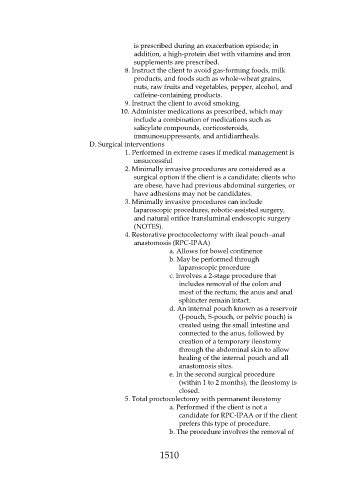Page 1510 - Saunders Comprehensive Review For NCLEX-RN
P. 1510
is prescribed during an exacerbation episode; in
addition, a high-protein diet with vitamins and iron
supplements are prescribed.
8. Instruct the client to avoid gas-forming foods, milk
products, and foods such as whole-wheat grains,
nuts, raw fruits and vegetables, pepper, alcohol, and
caffeine-containing products.
9. Instruct the client to avoid smoking.
10. Administer medications as prescribed, which may
include a combination of medications such as
salicylate compounds, corticosteroids,
immunosuppressants, and antidiarrheals.
D. Surgical interventions
1. Performed in extreme cases if medical management is
unsuccessful
2. Minimally invasive procedures are considered as a
surgical option if the client is a candidate; clients who
are obese, have had previous abdominal surgeries, or
have adhesions may not be candidates.
3. Minimally invasive procedures can include
laparoscopic procedures, robotic-assisted surgery,
and natural orifice transluminal endoscopic surgery
(NOTES).
4. Restorative proctocolectomy with ileal pouch–anal
anastomosis (RPC-IPAA)
a. Allows for bowel continence
b. May be performed through
laparoscopic procedure
c. Involves a 2-stage procedure that
includes removal of the colon and
most of the rectum; the anus and anal
sphincter remain intact.
d. An internal pouch known as a reservoir
(J-pouch, S-pouch, or pelvic pouch) is
created using the small intestine and
connected to the anus, followed by
creation of a temporary ileostomy
through the abdominal skin to allow
healing of the internal pouch and all
anastomosis sites.
e. In the second surgical procedure
(within 1 to 2 months), the ileostomy is
closed.
5. Total proctocolectomy with permanent ileostomy
a. Performed if the client is not a
candidate for RPC-IPAA or if the client
prefers this type of procedure.
b. The procedure involves the removal of
1510

